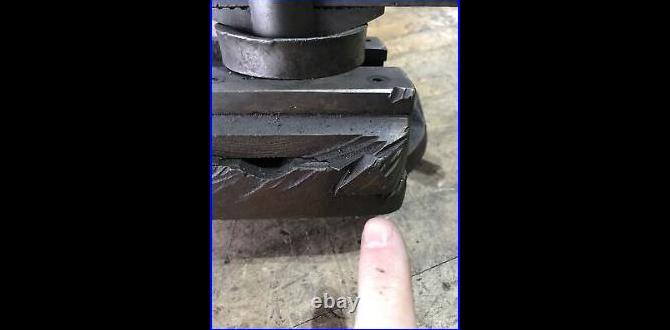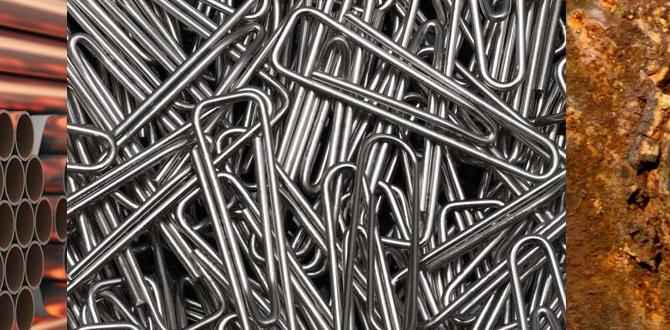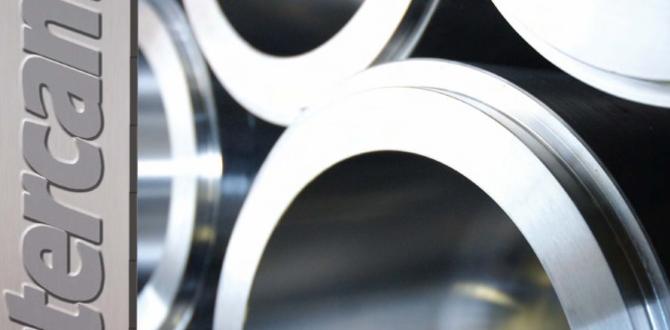A 1/8 inch carbide end mill, especially one designed to reduce chatter, offers a remarkably simple yet effective solution to achieve smoother cuts and more precise finishes on your milling projects, particularly with challenging materials.
Ever experienced that nerve-wracking vibration and awful screeching sound when your end mill bites into metal or plastic? That’s called chatter, and it’s a common headache for anyone using a milling machine. It not only ruins your workpiece with rough surfaces but can also damage your tools and machine. But what if I told you a specific type of tool, a 1/8 inch carbide end mill with a special design, could be your secret weapon against this frustrating phenomenon? It’s true! This small but mighty tool is a game-changer for achieving clean, precise cuts without the unwanted noise and vibration. We’re going to explore exactly why and how this tool works its magic, and by the end, you’ll be ready to conquer chatter on your next project.
Chasing Smooth Cuts: Understanding the Chatter Problem
Chatter. Just the word sends a shiver down the spine of many a machinist, from seasoned pros to eager beginners. Imagine you’re trying to mill a perfect slot, and instead of a clean path, your tool is bouncing around, making a terrible racket, and leaving a surface that looks like a washboard. That’s chatter in action. It’s a self-excited vibration that occurs when the cutting forces become unstable. These forces can cause the tool to momentarily lose contact with the workpiece, then slam back into it, creating a cycle of vibration.
This isn’t just an annoyance; chatter can lead to several problems:
- Poor Surface Finish: As mentioned, your workpiece will have a rough, uneven surface, often unsuitable for its intended purpose.
- Reduced Tool Life: The constant slamming and vibrating puts immense stress on your end mill, leading to premature wear, chipping, or even breakage.
- Damage to the Machine: Excessive vibration can also stress the spindle bearings, leadscrews, and other components of your milling machine, potentially leading to costly repairs.
- Inaccurate Dimensions: Chatter can cause the tool to cut inconsistently, making it difficult to achieve precise dimensions and tolerances.
Several factors can contribute to chatter, including:
- Tool Runout: If the end mill isn’t held perfectly true in the collet or holder, it will wobble as it spins.
- Machine Rigidity: Looseness in the machine’s ways or a flimsy structure can amplify vibrations.
- Cutting Parameters: Too fast a spindle speed, too slow a feed rate, or too deep a depth of cut can all encourage chatter.
- Tool Geometry: A standard end mill, especially a small one, might not be optimized to break up harmonic vibrations.
The Tiny Titan: Introducing the 1/8 Inch Carbide End Mill
When you think of milling, you might picture large, robust machines and substantial cutting tools. But some of the most intricate and delicate work requires exceptionally small tools. This is where the 1/8 inch carbide end mill shines. It’s designed for fine detail work, small slots, engraving, and machining intricate features that larger tools simply can’t manage.
Why 1/8 inch? This specific diameter is a sweet spot for many hobbyist and professional applications where precision is paramount. It’s small enough for detailed work on smaller projects, but robust enough for many common milling tasks on benchtop machines. However, the small diameter also makes it more susceptible to chatter if not chosen wisely.
Why Carbide?
The material of your end mill plays a crucial role in its performance. Carbide, also known as tungsten carbide, is a super-hard composite material. Compared to High-Speed Steel (HSS), carbide offers:
- Superior Hardness: It can withstand higher cutting temperatures and maintain its cutting edge longer.
- Increased Rigidity: Carbide is stiffer than HSS, meaning it deflects less under cutting load.
- Higher Cutting Speeds: Because it can handle heat, you can often run carbide tools at significantly faster spindle speeds.
For small tools like a 1/8 inch end mill, carbide’s rigidity is particularly beneficial. It helps the tiny cutting edges maintain their form and resist chipping, leading to cleaner cuts and longer tool life, even when dealing with challenging materials.
The “Genius Solution to Chatter” Feature: Unequal Helix/Flute Spacing
Now, let’s get to the heart of the matter: how a 1/8 inch carbide end mill can be a “genius solution to chatter.” The key lies in its specialized design, most commonly featuring unequal helix angles or unequal flute spacing. Standard end mills have equally spaced flutes and a consistent helix angle. This uniformity creates a predictable pattern of cutting engagement, which can easily excite certain natural frequencies of the tool and workpiece system, leading to chatter.
An end mill designed to reduce chatter will deviate from this uniformity in a few clever ways:
- Unequal Helix Angles: Instead of all flutes having the same spiral angle (e.g., 30 degrees), an anti-chatter end mill might have flutes with varying angles (e.g., 28°, 31°, 29°, 32°). This disrupts the regular impact of cutting edges on the material, preventing harmonic vibrations from building up.
- Unequal Flute Spacing: The angular distance between the flutes is not uniform. This means the cutting edges engage the workpiece at irregular intervals, again breaking the cycle that creates chatter.
- Variable Pitch: Some advanced designs incorporate a variable pitch along the cutting edge, further randomizing the cutting action.
These subtle geometric variations essentially ‘smear’ the cutting force over time and angle, making it much harder for the system to resonate at a problematic frequency. It’s like trying to get a crowd to clap in unison – it’s easy if everyone starts at the same time, but much harder if people start clapping at random intervals.
Choosing Your Chatter-Busting 1/8 Inch Carbide End Mill
When you’re on the hunt for this specific tool, here are some key specifications to look for:
Material
As we’ve discussed, Carbide is the way to go. Look for solid carbide end mills. PVD coatings can add further benefits like increased hardness, reduced friction, and extended tool life, making them even better at resisting wear and heat, which indirectly helps prevent chatter.
Shank Diameter
You specified a “1/8 inch shank.” This means the part that goes into your collet or tool holder is 1/8 inch in diameter. This is crucial for compatibility with small milling machines and collet systems. However, be aware that a very small cutting diameter on a very small shank can sometimes be a limitation in rigidity. For some chatter reduction, a slightly larger shank (e.g., 1/4 inch or 6mm) with a 1/8 inch cutting diameter might offer more stability, but if your machine requires a 1/8 inch shank, focus on the cutting enhancements.
Cutting Diameter and Length
The cutting diameter is also 1/8 inch. The overall length and the length of the cutting flutes will vary. For general-purpose milling, a standard length is fine. However, if you’re working in deep pockets or need to reach into cavities, you might look for an “extra long” version. Be mindful that longer tools are generally more prone to deflection and vibration, so an extra-long anti-chatter specific design is highly recommended for those applications.
Number of Flutes
For carbide end mills, common numbers of flutes are 2, 3, or 4.
- 2-Flute: Excellent for clearing chips, especially in softer materials like aluminum and plastics. They offer more space for chip evacuation, which can reduce binding and heat.
- 3-Flute: A good all-around choice, offering a good balance between chip clearance and rigidity. They can often be used in steels and harder materials than 2-flute.
- 4-Flute: Provide the best rigidity and surface finish in harder materials. However, chip evacuation can be more challenging, which can sometimes contribute to chatter if not managed well.
For chatter reduction, especially with a 1/8 inch diameter, a 2 or 3-flute design with the unequal helix/flute spacing is often preferred. The unequal spacing is the primary chatter-reducing feature, and having fewer flutes can enhance its effectiveness while still allowing for reasonable chip evacuation.
Application Specifics (e.g., Polycarbonate)
You mentioned a specific interest in polycarbonate. Polycarbonate is a thermoplastic that can be tricky to mill. It tends to melt rather than cut cleanly if too much heat is generated. It also has a tendency to chip or grab. For polycarbonate, specific considerations include:
- Sharp Cutting Edges: Essential to shear the plastic cleanly. Carbide excels here.
- Polished Flutes: Help reduce friction and heat buildup.
- Lower Spindle Speeds and Higher Feed Rates: Compared to metal, you often need to adjust your parameters to avoid melting.
- Chip Evacuation: Free chip flow is critical to prevent melting and clogging. A 2-flute design is often recommended.
- Anti-chatter geometry: Even more critical here, as the tendency to melt and grab can exacerbate vibration issues.
Therefore, a 1/8 inch carbide end mill with a 1/4 inch shank (for extra rigidity if compatible), 2 flutes, polished edges, ideal for plastics, and importantly, with unequal flute spacing or helix, would be a superb choice for polycarbonate.
Where to Find Them
Reputable tool manufacturers and suppliers are your best bet. Look for brands known for quality cutting tools. Websites specializing in machining tools, industrial supply companies, and even well-curated Amazon sellers (carefully check reviews and specifications) can be sources. Search terms like “anti-chatter end mill,” “harmonic dampening end mill,” “variable helix end mill,” or “unequal flute end mill” will help you find these specialized tools.
Table: Key Features of a Chatter-Reducing 1/8 Inch Carbide End Mill
| Feature | Importance for Chatter Reduction | Considerations for Polycarbonate |
|---|---|---|
| Material: Solid Carbide | High rigidity, maintains sharp edge, resists heat. Crucial for stability. | Excellent for clean shearing and heat resistance. |
| Geometry: Unequal Helix/Flute Spacing | Primary factor. Disrupts resonant frequencies, preventing vibration. | Essential to prevent grabbing and produce smooth cuts. |
| Flute Count: 2 or 3 | 2-Flute = good chip clearance (less binding). 3-Flute = good balance. | 2-Flute is often preferred for better chip evacuation and reduced heat. |
| Coatings (e.g., TiN, AlTiN) | Can improve surface finish, reduce friction, and extend tool life, indirectly aiding stability. | Uncoated or polished flutes might be preferred to minimize heat buildup, though some modern coatings are beneficial. |
| Shank Diameter | A larger shank diameter (e.g., 1/4″ or 6mm) can offer more rigidity if compatible with your machine. | Rigidity is always helpful, but ensure it fits your collet. |
| Cutting Edge Preparation (e.g., polished flutes) | Reduces friction and heat, leading to smoother cuts. | Highly important to prevent melting. |
Putting Your Chatter-Busting End Mill to Work: Best Practices
Even with the best tool, proper setup and technique are vital to banishing chatter. Think of the specialized end mill as a powerful assistant; you still need to know how to work with it effectively.
1. Secure the Workpiece Firmly
This seems obvious, but any movement in your workpiece is a direct invitation for chatter. Use clamps, vises, or fixtures that are appropriate for the size and material of your part. Ensure there’s no wiggle room whatsoever. For delicate plastics like polycarbonate, consider using a softer jaw material in your vise to avoid crushing the workpiece while still holding it securely.
2. Mount the End Mill Correctly
Use a clean, high-quality collet that matches your end mill shank precisely. A worn or incorrect collet will introduce runout, which is a major contributor to chatter. Ensure the end mill is inserted to the recommended depth into the collet – not too shallow and not so deep that the flutes are buried in the tool holder.
3. Dial in Your Cutting Parameters
This is where understanding your material and machine comes into play. While the specialized end mill helps enormously, optimal parameters are still key. Many end mill manufacturers provide recommended Surface Feet per Minute (SFM) and chip load recommendations for different materials. Use these as a starting point.
For Polycarbonate:
- Spindle Speed (RPM): Generally, you’ll use lower speeds than for metals. Start with something in the range of 5,000-15,000 RPM, depending on your machine and the specific end mill. Too high a speed can melt the plastic.
- Feed Rate (IPM or mm/min): This is crucial. You want to feed fast enough to shear the material cleanly rather than rub and melt it. A good starting point for 1/8 inch end mills in polycarbonate might be around 10-20 inches per minute, but of course, consult manufacturer data and experiment. The goal is to hear a distinct cutting sound, not a squealing or rubbing sound.
- Depth of Cut (DOC) and Width of Cut (WOC): For plastics, it’s often better to take shallower depths of cut and potentially multiple passes. This reduces the load on the tool and minimizes heat buildup. A shallow depth of cut (e.g., 0.010″ to 0.020″ for a 1/8″ end mill) is usually a good starting point. For slots, avoid full-width cuts if possible, which can increase the cutting force significantly.
A useful resource for calculating speeds and feeds is available from the National Institute of Standards and Technology (NIST). Their Advanced Manufacturing National Program Office provides data and tools that can help machinists. You can often find general guidelines on machining plastics from material suppliers as well. For example, PlasticsMakeItPossible.com offers insights into material properties of polycarbonate.
4. Consider Climb Milling vs. Conventional Milling
Climb Milling: The tool rotates in the same direction as the feed. This “pulls” the workpiece into the cutter. It generally results in a better surface finish and reduces tool pressure, which can be beneficial for reducing chatter. However, it requires a machine with minimal backlash in its feed system, as this can lead to the tool digging in.
Conventional Milling: The tool rotates against the direction of the feed. This “pushes” the workpiece away from the cutter. It’s more forgiving of backlash but can lead to a rougher finish and increase the tendency for chatter if not managed well.
For chatter-prone situations, especially with plastics where melting is a concern, climb milling is often the preferred method if your machine is capable.
5. Chip Evacuation: Keep it Clear!
For small diameter end mills, chip evacuation can be a challenge. Chips that don’t clear can recut, leading to increased heat, tool wear, and chatter.
- Use compressed air or a coolant mist (if appropriate for your machine and material) to blow chips away from the cutting zone.
- On machines with flood coolant, ensure it’s directed effectively.
- For plastics like polycarbonate, ensuring the flutes are clear is paramount to prevent melting.
6. Listen and Feel
Your ears and hands are excellent diagnostic tools. Pay attention to the sound and feel of the cut. A smooth, consistent whirring sound is what you want. A ringing, screeching, or chattering noise is a clear indicator that something is wrong: parameters are off, the workpiece is loose, or the tool is experiencing chatter. Stop the machine immediately and reassess.
When to Use Your Chatter-Busting End Mill
While the primary focus is chatter reduction, these specialized end mills excel in many situations:
- Intricate Detail Work: Engraving, fine lettering, intricate patterns where a clean finish is vital.
- Machining Plastics: Especially tricky ones like polycarbonate, acrylic, or ABS that tend to melt or chip.
- Small Slots and Pockets: When precision is a priority and standard end mills might vibrate.
- Aluminum Alloys







